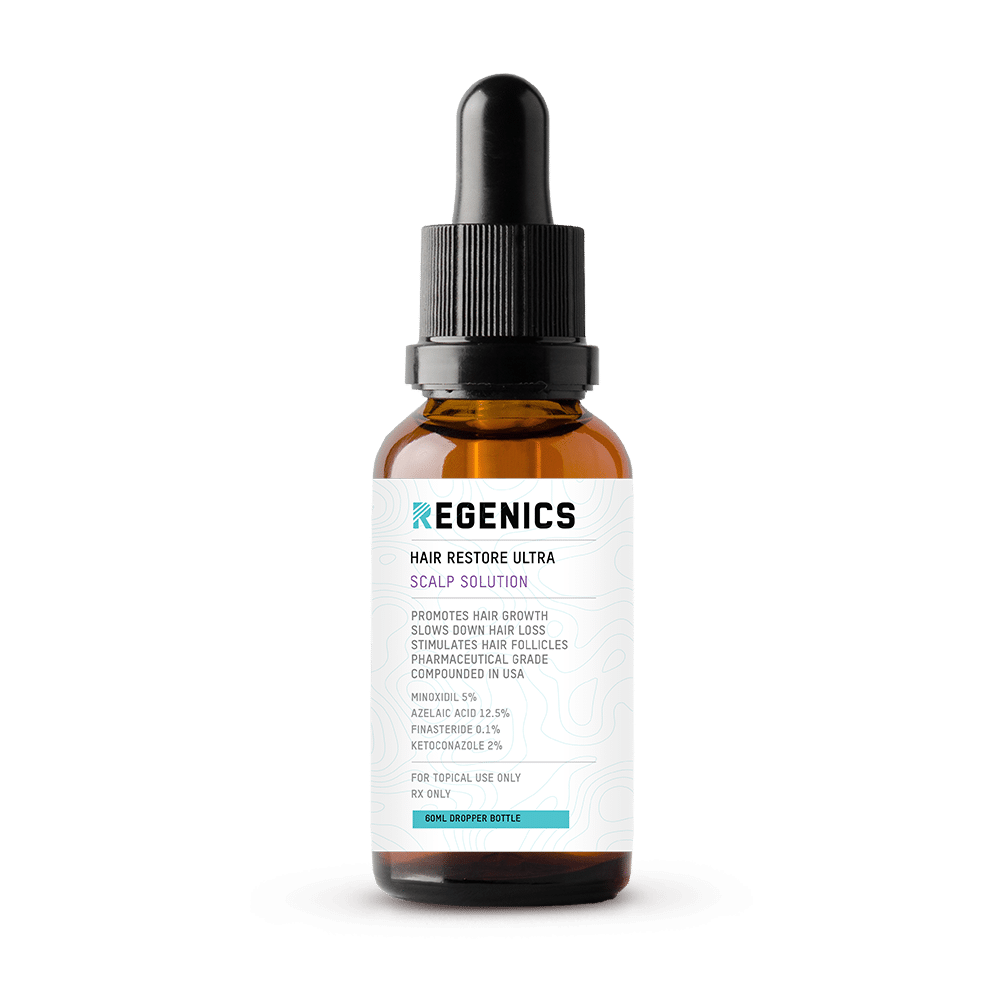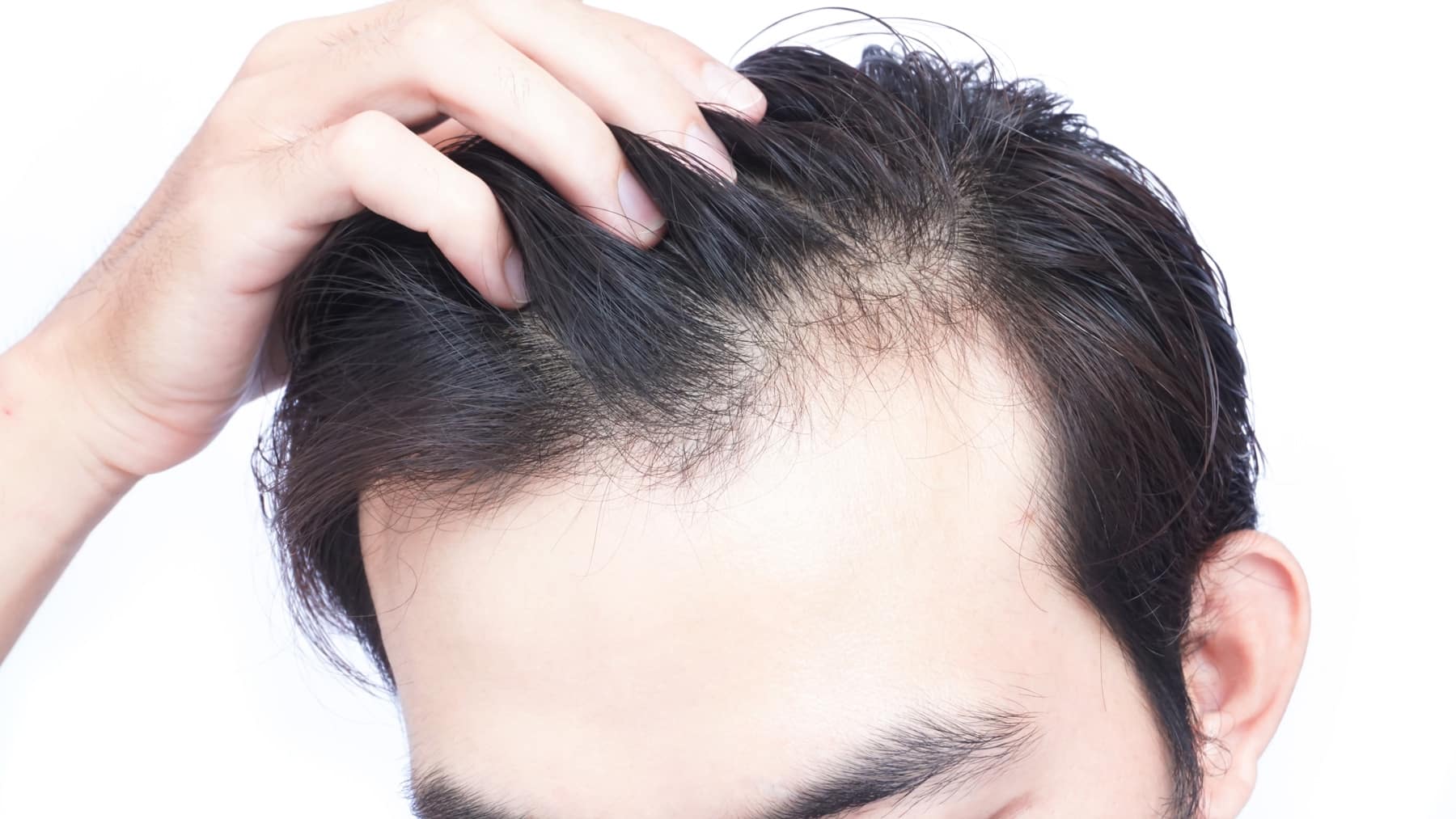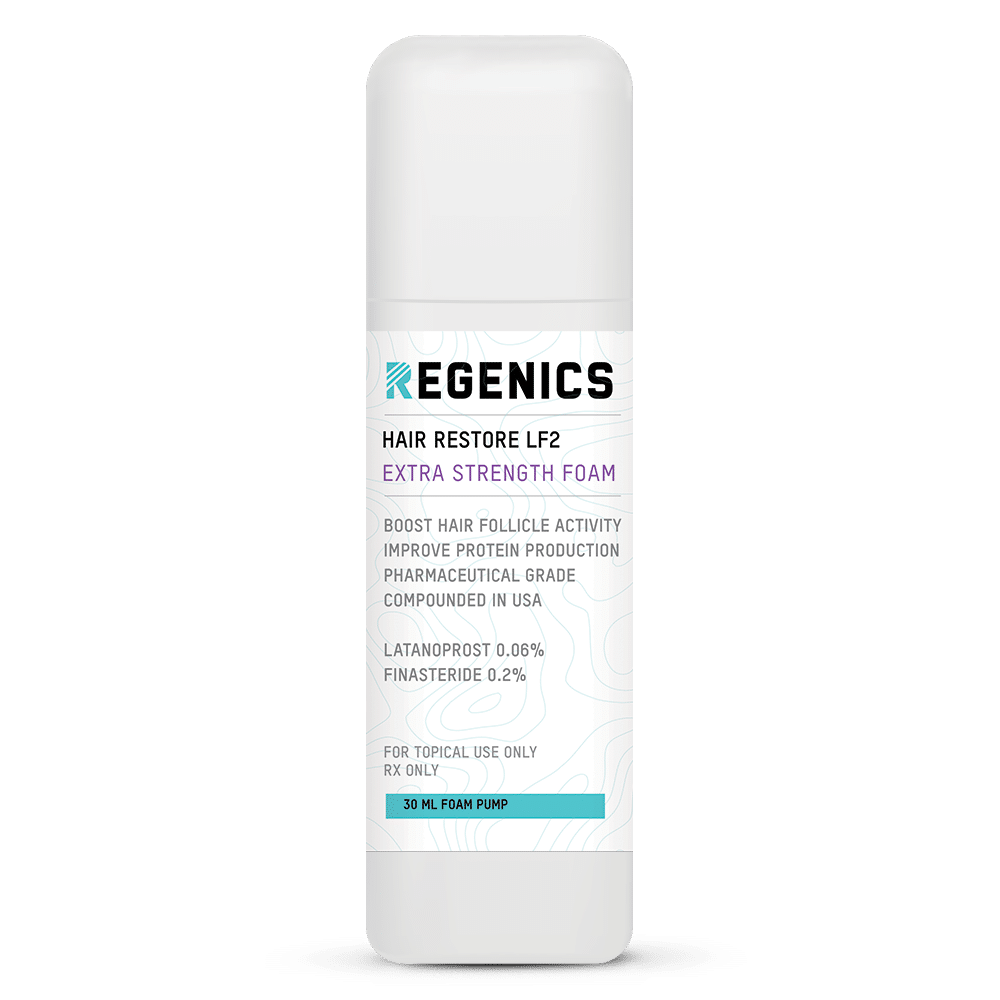Minoxidil
The adverse reaction profile for minoxidil depends upon its use. Systemic adverse reactions are unlikely from topical administration. Placebo-controlled trials with topical minoxidil only showed an increase in dermatological effects from the active drug.
Minoxidil is a peripheral vasodilator. All direct vasodilators produce a marked increase in plasma renin activity, which leads to water and sodium retention and sometimes congestive heart failure. This renin release is believed to be partially mediated by the beta-adrenergic system. The degree of fluid retention is somewhat related to the potency of the vasodilator. Due to its potency, fluid retention (edema) occurs routinely with oral minoxidil and usually requires concomitant administration of a loop diuretic. Without a diuretic, rapid fluid retention can occur within a few days of minoxidil therapy. Temporary edema occurred in 7% of patients who were not edematous when minoxidil was initiated. Ascites also has been reported. A restricted dietary intake of sodium can minimize fluid retention and resultant peripheral edema. Rarely, fluid retention is refractory to diuresis and discontinuation of minoxidil is required. Vasodilation may also produce headache.
Minoxidil causes reflex tachycardia; sinus tachycardia may occur. Angina may become apparent, or worsen, secondary to increased myocardial oxygen demand associated with tachycardia and increased cardiac output. Tachycardia and subsequent angina usually can be prevented with the coadministration of a beta-blocker or other sympathetic nervous system suppressant.
Minoxidil has been shown to transiently lower hematocrit, hemoglobin, and erythrocyte count by approximately 7%. Serum creatinine and BUN also have been shown to increase an average of 6% in patients on minoxidil therapy. Increases in alkaline phosphatase, without other evidence of hepatic abnormality, also has been reported. During the course of therapy, these laboratory abnormalities have been shown to return to pretreatment values. Thrombocytopenia and leukopenia also have been reported.
Hypertrichosis (elongation, thickening, and enhancement of fine body hair), without evidence of virilism or endocrine abnormalities, is an embarrassing adverse effect that often occurs with oral minoxidil. This effect is usually evident within 3—6 weeks of therapy and occurs on the temples, between the eyebrows, or in the sideburn area. Hair growth also can appear on the arms, legs, and scalp. It is reversible following discontinuation of the drug.
Oral minoxidil has occasionally been associated with appearance of a bullous rash and Stevens-Johnson syndrome. Topical minoxidil therapy produces local dermatological reactions including contact dermatitis, local burning, pruritus, erythema, or xerosis. Many other adverse effects have been reported during administration of topical minoxidil preparations, but none has been directly attributed to the drug.
Gastrointestinal adverse effects associated with orally administered minoxidil include nausea and vomiting.
Azelaic Acid
Most side effects occurring with the use of azelaic acid are dermatologic in nature and mild in severity. These effects include burning sensation or stinging (1—6.2%), paresthesias or tingling (1—6.2%), pruritus (1—5%), xerosis (dry skin, < 5%), erythema (< 2%), skin irritation (< 2%), contact dermatitis (< 1%), rash (unspecified) (< 1%), peeling (< 1%), dermatitis (< 1%), and edema (< 1%). In patients with dark complexions, skin hypopigmentation may occur. The following additional adverse reactions have been reported rarely: vitiligo depigmentation, small depigmented spots, hypertrichosis, reddening (signs of keratosis pilaris), and exacerbation of recurrent herpes viral infection (i.e., herpes labialis).
Post-marketing use of azelaic acid has been associated with the development of hypersensitivity reactions (including angioedema, ocular inflammation, facial swelling, and urticaria) and asthma exacerbation (i.e., dyspnea, wheezing). In addition, cases of iridocyclitis, or inflammation of the iris, have been noted following accidental exposure of the eye to the topical gel. Due to the voluntary nature of post-marketing reports, neither a frequency nor a definitive causal relationship can be established.
Finasteride
Adverse reactions to finasteride are generally mild and transient. In a long-term (4 years) clinical trial in men with benign prostatic hypertrophy (BPH) [25064], the most frequently reported adverse reactions to finasteride were related to sexual function. At 1 year, the adverse reactions reported to be drug-related were impotence (erectile dysfunction), decreased libido, decreased ejaculate volume, ejaculation dysfunction, breast enlargement, breast tenderness (mastalgia), and rash (unspecified). There was no significant difference between finasteride and placebo in the incidences of impotence, decreased libido, and ejaculation dysfunction in years 2 to 4 of the study. However, during post marketing surveillance, continued erectile dysfunction, orgasm dysfunction or other orgasm disorders, and ejaculation dysfunction following treatment discontinuation have been reported. From June 1992, when finasteride was approved, until February 1995, the FDA received reports of gynecomastia in 214 men (median age: 71 yrs). Most were taking a dose of 5 mg/day PO. Gynecomastia has been the most frequently reported adverse effect of this drug since it was marketed. The onset of gynecomastia ranged from 14 days to 2.5 years (median: 180 days). Thirty percent had unilateral gynecomastia, 25% had bilateral involvement, and, in the remainder of reports, this information was not specified. Twenty-seven percent of patients were also taking other medications that are known to cause gynecomastia. Gynecomastia resolved either completely or partially in 80% of subjects after finasteride was discontinued, however, in at least 2 cases, a new primary malignancy of primary intraductal breast cancer subsequently developed. In a 4 to 6 year trial where patients were randomized to receive finasteride 5 mg/day, doxazosin 4 or 8 mg/day, a combination of the two drugs, or placebo, four patients reported breast cancer as an adverse experience; three of the patients were receiving finasteride therapy and one patient was receiving combination therapy. In addition, male breast cancer has been reported during post-marketing experience. Other post-marketing adverse reactions have included depression, testicular pain that continued after discontinuation of treatment, and hypersensitivity reactions including pruritus, urticaria, and angioedema (including swelling of the lips, tongue, throat, and face).
In controlled trials of finasteride for the treatment of male pattern hair loss, 1.4% of patients discontinued therapy due to adverse events, compared with 1.6% of placebo-treated patients. Discontinuation of therapy because of a drug-related sexual adverse experience occurred in 1.2% of patients on finasteride and 0.9% of patients on placebo. The following adverse events were reported as at least possibly drug-related in finasteride-treated patients: libido decrease (1.8%), impotence (1.3%), and ejaculation disorder (1.2%), primarily decreased ejaculate volume. The incidence of each of the above adverse effects decreased to <= 0.3% by the fifth year of treatment. During post marketing surveillance, decreased libido and libido disorders that continued after discontinuation of treatment was reported.
Finasteride may cause spermatogenesis inhibition or oligospermia, decreased sperm motility, or decreased semen volume. The clinical significance of finasteride’s effect on semen characteristics for an individual male patient’s fertility is not known; consider the potential effects on semen when assessing a male with infertility. In a 52-week, randomized, double-blind, placebo-controlled study in healthy men, finasteride (5 mg PO once daily) significantly decreased total sperm count (-34.3%) compared to baseline at 26 weeks but not at 52 weeks or at the 24-week follow-up. Semen volume was decreased at 52 weeks for finasteride (-14.5%), but the effect was not statistically significant. Sperm concentration was decreased by finasteride (-7.4%) but was not significant for either drug. Significant reductions of 6 to 12% in sperm motility were observed during treatment. Sperm morphology was not affected. One subject taking finasteride had decreases in sperm count of more than 90% of baseline values at 52 weeks; partial recovery was noted at the 24-week follow-up. During post marketing surveillance, male infertility and/or poor seminal quality following treatment discontinuation have been reported. It should be noted that normalization or improvement of seminal quality has also been reported after discontinuation of finasteride.
By inhibiting the conversion of testosterone to DHT, finasteride and other 5-alpha-reductase inhibitors have the ability to cause teratogenesis, specifically abnormalities in the external genitalia of the male fetus (e.g., hypospadias).
Ketoconazole
Approximately 3% of patients receiving oral ketoconazole experience episodes of nausea and vomiting. This usually is transient and may improve when ketoconazole is given with food, which also can increase oral bioavailability. Other ketoconazole-associated gastrointestinal adverse reactions include abdominal pain and diarrhea which were reported in 1.2% and less than 1% of patients, respectively. Cases of cheilitis have been noted during postmarketing use of ketoconazole topical foam. Due to the voluntary nature of postmarketing reports, neither a frequency nor definitive causal relationship can be established.
Ketoconazole can inhibit testosterone secretion at doses of 200—400 mg/dayand can inhibit cortisol synthesis in doses of 400—600 mg/day. Inhibition of testosterone synthesis has led to cases of gynecomastia and impotence (erectile dysfunction) in < 1% of men. Serum testosterone concentrations return to baseline and gynecomastia and impotence usually abate after ketoconazole therapy is stopped. Oligospermia has been reported in patients receiving systemic ketoconazole in investigational studies. This was mainly at doses above those approved. Oligospermia was not reported at doses up to 400 mg/day; however, sperm counts are not frequently obtained at these doses.
Rare cases of anaphylactoid reactions have been reported following the first dose of oral ketoconazole and during post-marketing use of the 2% shampoo. Several cases of hypersensitivity reactions including urticaria and angioedema have also been reported. Fever and chills have been reported in < 1% of patients receiving systemic ketoconazole. Facial swelling has been reported in < 1% of patients using the topical gel formulation.
Dizziness, drowsiness (somnolence), and headache have been reported in < 1% of patients receiving treatment with oral ketoconazole. Neuropsychiatric events have also been reported rarely and include suicidal ideation and severe depression. Headache and dizziness were also reported in < 1% of patients using the topical gel formulation.
Photophobia occurs in < 1% of patients receiving treatment with oral ketoconazole. To minimize discomfort, the patient should wear sunglasses while outside and avoid bright light when possible. Treatment-related ophthalmic adverse events reported in < 1% of patients using the topical gel include ocular irritation, ocular swelling, and keratoconjunctivitis sicca.
Post-marketing worldwide reports in patients receiving oral ketoconazole have included rare cases of paresthesias, and signs of increased intracranial pressure including bulging fontanelles and papilledema. Hypertriglyceridemia has also been reported with the oral formulation but a causal relationship with ketoconazole has not been determined. Paresthesias have also been reported in <= 1% of patients using the topical foam and in < 1% of patients using the topical gel.
Dermatologic reactions were reported with systemic and topical ketoconazole formulations. Pruritus has been reported in 1.5% of patients receiving oral ketoconazole; it has also been reported following application of the topical cream, topical foam (up to 1%), topical gel (less than 1%), and the shampoo. Alopecia has been reported with the shampoo and with worldwide postmarketing reports in patients receiving the oral formulation. Skin irritation has been reported with topical use, specifically with the cream (as pruritus, burning, and stinging), the foam (up to 1%), the gel (less than 1%), and the shampoo. Contact dermatitis was reported with use of the shampoo and postmarketing with the cream; application site dermatitis was reported with use of the gel (less than 1%). The topical foam (Extina) was associated with an increased incidence of contact sensitization, including photosensitivity in dermal safety studies. Application site reaction (6%) and burning (10%) were reported with ketoconazole foam, burning was also reported with the gel (4%) and the shampoo. Skin dryness or xerosis was reported with use of the foam (up to 1%), the gel (less than 1%), and the shampoo. Erythema was reported with use of the foam (up to 1%) and the gel (less than 1%). Rash (unspecified) was reported with use of the foam (up to 1%) and the shampoo. Warmth at the application site was noted in up to 1% of patients using the foam. Pustules were noted on the skin with application of the gel (less than 1%) and on the scalp with application of the shampoo. Other reactions noted in less than 1% of patients who used the topical gel include discharge, pain, impetigo, pyogenic granuloma, acne vulgaris, and nail discoloration. Adverse reactions specifically noted with use of the shampoo include hair discoloration, abnormal hair texture and removal of curl, rash (unspecified), and application site reactions.
Systemic ketoconazole can prolong the QT interval. Serious cardiovascular events, QT prolongation, ventricular arrhythmias, and torsade de pointes, have been observed in patients receiving ketoconazole oral tablets in combination with other QT-prolonging drugs.
Ketoconazole alters vitamin D metabolism and may lead to vitamin D deficiency. Patients should be monitored and supplemented with vitamin D if necessary.




